Panasonic KX-TG2581ALS, KX-TG2581NZS User Manual
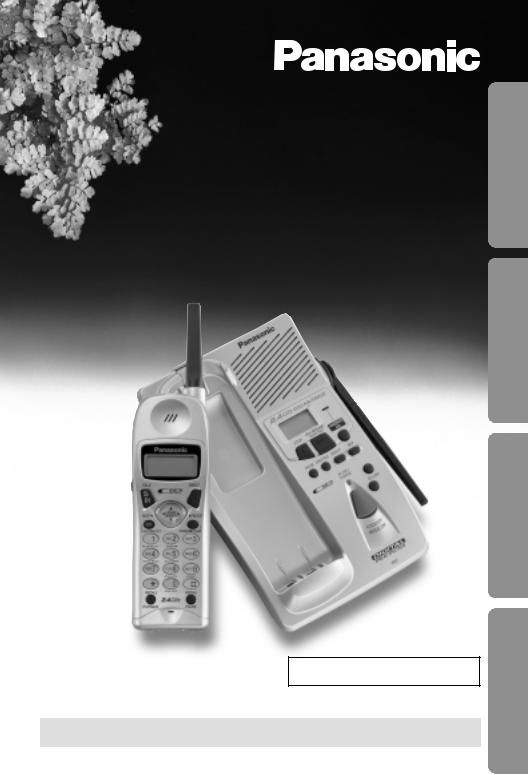
2.4GHz Digital Cordless Answering System
Operating Instructions
Model No. KX-TG2581ALS
KX-TG2581NZS
Caller ID Compatible
PLEASE READ BEFORE USE AND SAVE.
Charge the battery for about 6 hours before initial use.
Information Useful System Answering Telephone Cordless Preparation
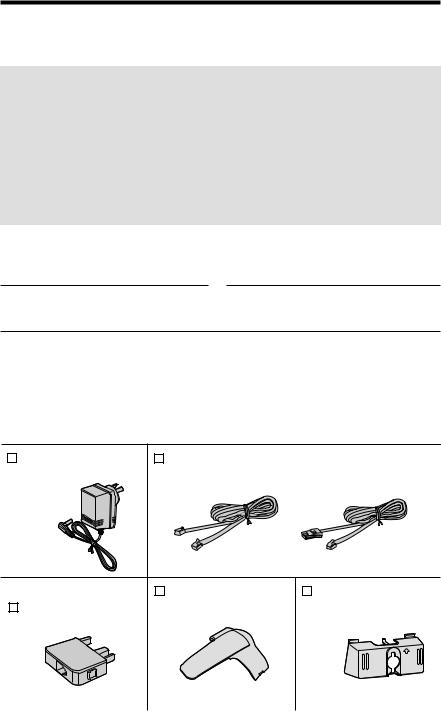
Before Initial Use
Thank you for purchasing your new Panasonic cordless telephone.
For Australia
When you subscribe to Caller ID services from your telephone operator, this telephone will display the caller’s phone number. When available from your telephone operator, this telephone will also display the number of the second call or call waiting.
For New Zealand
Caller ID, where available, is a service provided by the telephone company. After subscribing to Caller ID, this phone will display a caller’s phone number.
For your future reference
Serial No. |
Date of purchase |
(found on the bottom of the unit)
Name and address of dealer
Attach or keep original receipt to assist with any repair under warranty.
Accessories (included)
AC Adaptor (p. 12) |
Telephone Line Cord (p. 12) |
|
|
For Australia |
For New Zealand |
one |
one |
one |
For Australia only |
Belt Clip (p. 15) |
Wall Mounting |
Telephone Plug |
|
Adaptor (p. 66) |
(p. 12) |
|
|
one |
one |
one |
2

For Best Performance
Battery Charge
A rechargeable Nickel Cadmium (Ni-Cd) battery powers the handset. Charge the battery for about 6 hours before initial use (p. 13).
•As preventative maintenance, clean the handset and the base unit charge contacts with a soft, dry cloth once a month. Clean more often if the unit is subject to grease, dust or high humidity. Otherwise the battery may not charge properly.
The battery is beneath this cover. 
Base Unit Location/Noise
Calls are transmitted between the base unit and the handset using wireless radio waves. For maximum distance and noise-free operation, the recommended base unit location is:
Away from electrical appliances such as a TV, personal computer, cellular phone charging units or another cordless phone.
Raise the antenna.
In a high and central location, preferably where there are no obstructions.
Note:
While using the handset:
•If you are near a microwave oven which is being used, noise may be heard from the receiver. Move away from the microwave oven and closer to the base unit.
•If more than one cordless phone is being used and your handset is near another cordless phone’s base unit, noise may be heard. Move away from the other cordless phone’s base unit and closer to your base unit.
3

Contents |
|
Preparation |
|
Location of Controls..................................................................... |
6 |
Displays ......................................................................................... |
8 |
Settings.......................................................................................... |
12 |
Connections................................................................................. |
12 |
Battery Charge ............................................................................ |
13 |
Using the Belt Clip....................................................................... |
15 |
Using an Optional Headset ......................................................... |
15 |
Selecting the Line Mode.............................................................. |
16 |
Programmable Functions ............................................................ |
17 |
Setting the Auto Talk Feature...................................................... |
18 |
Selecting the Ringer Volume....................................................... |
19 |
Selecting the LCD Contrast......................................................... |
20 |
Preparing the Answering System ............................................... |
21 |
Greeting Message ....................................................................... |
21 |
Programming Summary for the Answering System .................... |
23 |
Day and Time Adjustment ........................................................... |
24 |
Selecting the Caller’s Recording Time ........................................ |
26 |
Selecting the Number of Rings.................................................... |
27 |
Cordless Telephone |
|
Making Calls.................................................................................. |
28 |
Answering Calls............................................................................ |
30 |
Caller ID Service ........................................................................... |
31 |
Using the Caller List ..................................................................... |
33 |
Viewing the Caller List................................................................. |
33 |
Calling Back from the Caller List ................................................. |
35 |
Editing the Caller’s Phone Number ............................................. |
36 |
Storing Caller List Information in the Directory............................ |
37 |
Erasing Caller List Information .................................................... |
38 |
One-Touch Dialler......................................................................... |
40 |
Storing a Phone Number in the DIRECT Button ......................... |
40 |
Dialling the Stored Number in the DIRECT Button ..................... |
40 |
Using the Directory....................................................................... |
41 |
Storing Names and Numbers in the Directory ............................ |
41 |
Selecting Characters to Enter Names ........................................ |
43 |
Finding Items in the Directory .................................................... |
45 |
Dialling from the Directory .......................................................... |
46 |
Editing an Item in the Directory .................................................. |
47 |
Erasing an Item from the Directory ............................................ |
48 |
Intercom......................................................................................... |
49 |
4

Special Features ........................................................................... |
50 |
Automatic Security Code Setting................................................. |
50 |
Call Waiting and Caller ID Compatible (For Australia only) ........ |
50 |
How to Use the PAUSE Button |
|
(For PBX Line/Long Distance Calls) ........................................ |
51 |
RECALL Button ........................................................................... |
51 |
Answering System |
|
Automatic Answering Operation................................................. |
53 |
Setting the Unit to Answer Calls.................................................. |
53 |
Listening to Messages ................................................................. |
54 |
Slow Talk Message Playback...................................................... |
54 |
From the Handset........................................................................ |
56 |
Erasing Messages ........................................................................ |
57 |
Remote Operation from a Touch Tone Phone ........................... |
58 |
Setting the Remote Code ............................................................ |
59 |
Voice Menu.................................................................................. |
60 |
Direct Remote Operation............................................................. |
62 |
Remote Operation with the Handset........................................... |
64 |
Useful Information |
|
Wall Mounting ............................................................................... |
66 |
Battery Replacement .................................................................... |
68 |
Adding Another Phone................................................................. |
69 |
Troubleshooting ........................................................................... |
70 |
Safety Instructions ....................................................................... |
75 |
Specifications ............................................................................... |
77 |
Important Information (For Australia only) ................................ |
78 |
System Answering Telephone Cordless Preparation
Information Useful
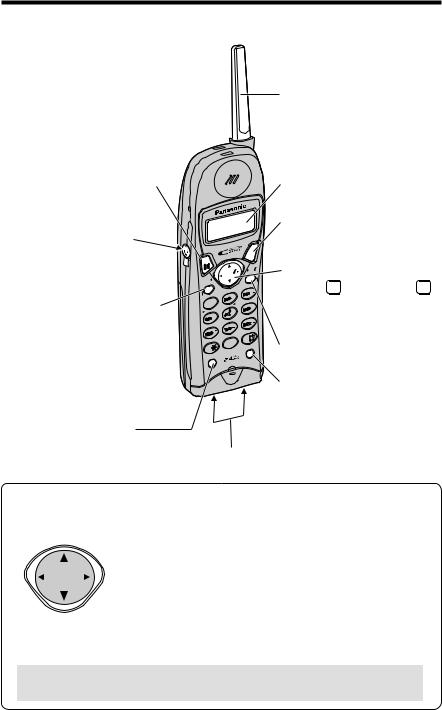
Location of Controls
Handset
Antenna
(TALK) Button (p. 28, 30)
Headset Jack (p. 15)
(FUNCTION/EXIT/CH)
(Channel) Button
(p. 17, 23, 28, 33, 41, 51)
(RECALL/PLAYBACK)
Button (p. 50, 51, 64)
TALK |
|
|
|
|
ON |
|
|
|
|
OFF |
|
|
|
|
|
|
|
LOU |
D |
|
|
|
SEAR |
CH |
|
|
|
|
|
BACK |
|
|
|
|
CH |
|
/EXIT |
|
|
FUNCTION |
|
2 |
||
|
|
|||
|
1 |
|
||
|
SKIP |
|||
REP |
EAT |
|
5 |
|
|
|
|
||
|
4 |
|
||
|
|
SG |
||
|
MSG |
ALLM |
||
NEW |
|
8 |
||
7 |
|
|
||
|
|
N |
||
|
|
|
ANSO |
|
|
|
|
|
0 |
|
|
|
ANS |
OFF |
|
|
|
|
|
RECALL |
|
PLAYB |
ACK |
DIRECT |
|
FWD |
EDIT |
INTERCOM/CLEAR |
|
3 |
|
6 |
|
9 |
|
STOP |
|
REDIAL |
|
PAUSE |
|
Display (p. 8)
(DIRECT) Button (p. 40)
Navigator Key (
 ,
,
 ,
,
BACK  , FWD/EDIT
, FWD/EDIT  ) (p. 17, 23, 29, 33, 41)
) (p. 17, 23, 29, 33, 41)
(INTERCOM/CLEAR)
Button (p. 38, 48, 49)
(REDIAL/PAUSE) Button (p. 28, 51)
Charge Contacts (p. 14)
How to use the Navigator key
This key has four active areas that are indicated by arrows.
LOUD
SEARCH
•Pressing the up and down arrows allows you to enter the Caller List and scroll through the function menu, the Caller List and the directory list. The up and down arrows are also used to adjust the handset ringer and receiver volumes.
•Pressing the right and left arrows allows you to enter the directory list and to move the cursor when entering directory items.
•The right arrow is also used to select or confirm your menu choices.
Throughout these Operating Instructions, the navigator key is indicated by the arrows Ö, Ñ, Ü or á.
6
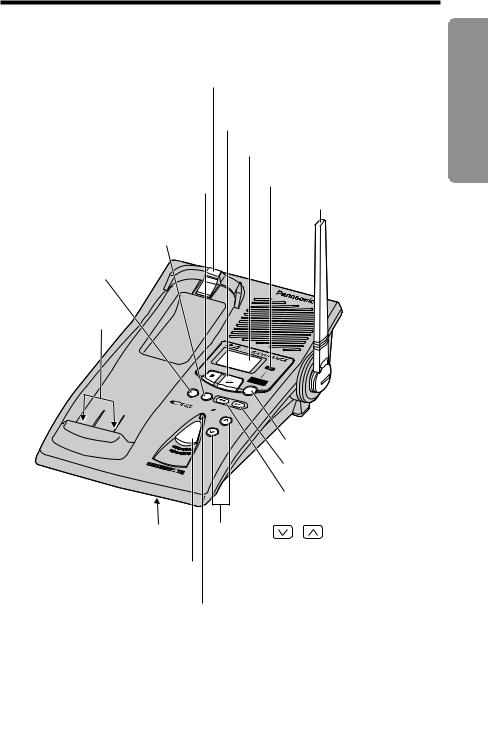
Base unit
Hook (p. 66)
(NEWÒMESSAGE/SLOW!TALK)
Button (p. 54) Display (p. 11)
(STOP) Button (p. 21, 55) ANSWER ON Indicator (p. 53) Antenna (p. 3, 12)
(GREETING) Button (p. 21)
(ERASE) Button (p. 22, 57)
Charge Contacts (p. 14)
STOP
INUSE
CHARGE
VOLUME
SPREAD |
SPECTR |
|
|
|
UM |
MIC |
|
NEW MES |
|
SLOW |
SAGE/ |
|
TALK |
|
A |
|
NSWER |
|
ON |
SKIP
(ANSWERÒON) Button (p. 53)
(SKIP) Button (p. 55)
(REPEAT) Button (p. 55)
MIC (Microphone) |
VOLUME , |
(p. 21, 49) |
Buttons (p. 21, 54) |
(LOCATOR/INTERCOM)
Button (p. 49)
IN USE/CHARGE
Indicator (p. 13)
Preparation

Displays
Both the handset and the base unit show you instructions and information on their displays. These display prompts are shown below.
Handset display
No items stored
Recharge
12 new calls
12 new calls GF H=Directory
The Caller List is empty or there are no stored items in the directory.
The battery needs to be charged. Place the handset on the base unit to charge the battery (p. 14).
The display shows the number of new calls and the battery strength while the handset is on the base unit.
This display shows the number of new calls when Ö or Ñ is pressed while the handset is off the base unit.
To search from the most recent call, press Ö. To search from the oldest call, press Ñ (p. 33). To go to the directory list, press FWD/EDIT á
(Directory key).
Ringer off
0266667777
Talk
01-06-35
When the handset ringer volume is set to OFF (p. 19), “Ringer off” will flash for about 45 seconds before the handset returns to the standby mode (p. 14).
When a call is received, the display shows the caller’s phone number after the first ring.
During a conversation, the display shows the length of the call (ex. 1 hour, 6 minutes and 35 seconds). The battery strength is also displayed (p. 13).
8

No link to base Place on cradle and try again.
0355566677 11:20A JAN10 3
The handset has lost communication with the base unit. Place the handset on the base unit and try again.
This is an information from the Caller List. The display shows:
—the caller’s phone number,
—the time and date of the last call (ex. Jan. 10, 11:20 AM), and
—the number of times called (ex. 3 times).
Preparation
Ann 0267543210
Paging
Press INTERCOM
Intercom
00-00-07
0266667777
----Waiting----
This is a name from the directory. The stored name and phone number are displayed.
The base unit is paging the handset (p. 49).
The handset and the base unit are in the intercom mode (p. 49).
A second call is received during a conversation (p. 50).

Displays
Please lift up and try again.
Not available
Directory full
Save error
Time/day Adj.→ 0 See manual for other settings.
Remote operation
Ö, Ñ, BACK Ü or FWD/EDIT á was pressed while the handset was on the base unit. Lift the handset and press the button again.
While the base unit was not in the standby mode, Ö or Ñ was pressed to search the Caller List/directory list, FWD/EDIT á was pressed to select an option or (INTERCOM/CLEAR) was pressed.
When trying to store an item or Caller List information in the directory, the directory memory is full (p. 37, 42).
While storing items in the directory, the handset has lost communication with the base unit. Move closer to the base unit and try again.
The unit is in answering system programming mode (p. 23).
The handset is operating the answering system remotely (p. 64).
10
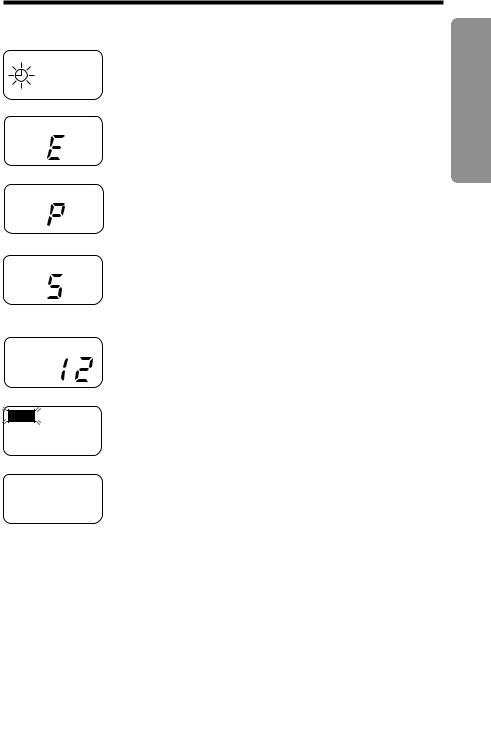
Base unit display
FULL
The clock needs adjusting (p. 24).
Your greeting message was not recorded correctly. Record it again (p. 21).
The unit is in the answering system programming mode.
The speaker volume level is set to “5”.
You can select 9 levels (0–8) while using the answering system (p. 53) or the intercom
(p. 49).
12 messages have been recorded.
Memory is full. Erase some or all of the messages (p. 57).
The recording time is set to “Greeting only” (p. 26). (The display is blank.)
Preparation

Settings
Connections
For Australia
To Socket
Telephone Line Cord
Fasten the cords to prevent them from being disconnected.
Hook Hooks
Telephone
Plug
For New Zealand
To Single-Line
Telephone Jack
Telephone Line Cord
To Power Outlet
(AC 230 V-240 V,
50 Hz)
AC Adaptor
OR
Raise the antenna.
•USE ONLY WITH Panasonic AC ADAPTOR PQLV10AL.
•The AC adaptor must remain connected at all times. (It is normal for the adaptor to feel warm during use.)
•To connect a standard telephone on the same line, see page 69.
•If your unit is connected to a PBX which does not support Caller ID services, you cannot access those services.
•KX-TG2581AL and KX-TG2581NZ are not designed to be used with rotary (pulse dialling) services.
•KX-TG2581NZ will not answer incoming calls on your FaxAbility number.
12

Battery Charge
Place the handset on the base unit and charge for about 6 hours before initial use.
• The IN USE/CHARGE indicator lights and a beep sounds.
OR
Preparation
IN USE/CHARGE Indicator
Battery strength
You can check the battery strength on the handset display while the handset is on the base unit, while it is in use (making/answering a call etc.), or after viewing the Caller List or directory items, programming etc. The battery strength will remain for a few seconds after using the handset, then the display will return to the standby mode (p. 14).
The battery strength is as shown in the chart below.
Display prompt |
Battery strength |
|
|
Fully charged
Medium
Low
|
|
(flashing) |
Needs to be recharged. |
|
|

Settings
Recharge
Recharge the battery when: |
|
|
|
|
|
||||
—“Recharge” is displayed on the handset, |
Recharge |
|
|
|
|||||
—“ |
|
|
|
” flashes on the display, or |
|
|
|
|
|
|
|
|
|
|
|
|
|
||
|
|
|
|
|
|
|
|
||
—the handset beeps intermittently while it is in use.
• If you DO NOT recharge the handset battery for more than 15 minutes, the display will keep indicating “Recharge” and/or “ 
 ” will continue to flash.
” will continue to flash.
• To fully recharge the battery, the handset should be left on the base unit.
Battery information
After your Panasonic battery is fully charged (p. 13):
|
Operation |
Operating time |
|
|
|
|
|
While in use |
|
near the base unit* |
Up to 4.5 hours |
|
|
|
|
(TALK) |
|
away from the base unit |
Up to 3.5 hours |
|
|
|
|
While not in use (Standby) |
Up to 11 days |
||
|
|
|
|
*Within about 3 meters
•The battery operating time may be shortened depending on usage conditions, such as viewing the Caller ID Caller List or directory list, and ambient temperature.
•As preventative maintenance, clean the handset and the base unit charge contacts with a soft, dry cloth once a month. Clean more often if the unit is subject to grease, dust or high humidity. Otherwise the battery may not charge properly.
•If the battery is fully charged, you do not have to place the handset on the base
unit until “Recharge” is displayed and/or “ |
|
|
” flashes. This will maximize the |
battery life. |
|
|
|
• The battery cannot be overcharged. |
|
|
|
Standby Mode (While the handset is off the base unit)
The handset goes into the standby mode after you finish using the handset (making/answering a call, viewing the Caller List or directory list etc.). The display is blank, but the handset can receive calls. The battery operating time is conserved in this mode.
14

Using the Belt Clip
You can hang the handset on your belt or pocket using the belt clip.
To attach the belt clip |
To remove the belt clip |
Using an Optional Headset
Plugging an optional headset into the handset allows a hands-free phone conversation. Please use only the Panasonic KX-TCA88AL headset.
Only telecommunications compliance labelled headsets should be plugged into the headset jack on the handset.
Connection an optional headset to the handset
Open the headset jack cover, and connect the headset to the headset jack as shown below.
Preparation
H
Headset Jack
When the optional headset is connected to the handset, make sure to use the headset to talk with the caller. If you want to have a normal cordless phone conversation, disconnect the headset.

Settings
Selecting the Line Mode
If the line is connected to a low voltage system such as a PBX, set to “B”. Otherwise the Call Waiting Caller ID Feature may not be used (p. 50). Your phone comes from the factory set to “A”.
Use the handset near the base unit.
Make sure the unit is in the standby mode initially.
1 |
Press (FUNCTION/EXIT/CH). |
|
HSave directory |
|||
|
|
|
Ringer volume |
|||
|
|
|
|
GF |
|
H=Yes |
2 |
|
|
|
|
|
|
Press Ö or Ñ repeatedly until the arrow |
|
|
|
|||
HProgram |
|
|
||||
points to “Program”. |
LCD contrast |
|||||
|
|
|
|
GF |
|
H=Yes |
3 |
Press FWD/EDIT á (Yes key). |
|
|
|||
|
|
|||||
|
|
HSave DIRECT# |
||||
|
|
|
Recall time |
|||
|
|
|
|
GF |
H=Yes |
|
4 |
|
|
|
|
||
Press Ö or Ñ repeatedly until the arrow |
|
|
|
|||
HSet line mode |
||||||
points to “Set line mode”. |
Talk switching |
|||||
|
|
|
|
GF |
|
H=Yes |
5 |
Press FWD/EDIT á (Yes key). |
|
|
|||
|
|
|||||
Line mode |
:A |
|||||
|
|
|
|
GF |
H=Save |
|
6 |
Press Ö or Ñ to select “B” or “A”. |
|
|
|||
|
|
|||||
Line mode |
:B |
|||||
|
|
|
|
GF |
H=Save |
|
7 |
Press FWD/EDIT á (Save key). |
|
|
|||
|
|
|
||||
Line mode |
|
|||||
• A beep sounds. |
|
|
:B |
|||
•To return to the standby mode, press
(FUNCTION/EXIT/CH).
•You can exit the programming mode any time by pressing (FUNCTION/EXIT/CH).
•If the handset has lost communication with the base unit, 3 beeps sound and “No link to base Place on cradle and try again.” is displayed.
16

Programmable Functions
You can program the following functions by using the handset near the base unit. The display shows the programming instructions. See the corresponding pages for function details.
Make sure the unit is in the standby mode initially.
Lift the handset, and press (FUNCTION/EXIT/CH).
<Function menu>*
HSave directory........ To store an item in the directory (p. 42). Ringer volume .......... To select the ringer volume (p. 19).
Program
LCD contrast............. To select the LCD contrast (p. 20). Press FWD/EDIT á.
<Function menu>*
HSave DIRECT#............. To store a phone number in the DIRECT button (p. 40).
Recall time ............... To select the recall time (p. 51). Set line mode .......... To select the line mode (p. 16). Talk switching........ To set the auto talk feature (p. 18).
TAD program................ To program answering system functions (p. 23).
Preparation
During programming:
*To select a desired function item, press Ö or Ñ repeatedly until the arrow points to the item. Then press FWD/EDIT á to go to the next step.
•You can exit the programming mode any time by pressing (FUNCTION/EXIT/CH).
•If you do not press any buttons for 60 seconds, the unit will return to the standby mode.
•If the handset has lost communication with the base unit, 3 beeps sound and “No link to base Place on cradle and try again.” is displayed.

Programmable Functions
Setting the Auto Talk Feature
The Auto Talk feature allows you to answer a call by lifting the handset off the base unit without pressing (TALK). If you want to use this feature, turn the feature ON by programming. Your phone comes from the factory set to OFF.
Make sure the unit is in the standby mode initially.
1 |
Press (FUNCTION/EXIT/CH). |
|
|
|
2 |
Press Ö or Ñ repeatedly until the arrow |
|
|
|
HProgram |
|
|||
points to “Program”. |
|
|||
LCD contrast |
||||
|
|
GF |
H=Yes |
|
3 |
Press FWD/EDIT á (Yes key). |
|
|
|
|
|
|||
4 |
Press Ö or Ñ repeatedly until the arrow |
|
||
Set line mode |
||||
points to “Talk switching”. |
HTalk switching |
|||
|
|
GF |
H=Yes |
|
5 |
Press FWD/EDIT á (Yes key). |
|
|
|
|
|
|||
Auto talk |
||||
|
||||
|
|
:Off |
||
|
|
GF |
H=Save |
|
6 |
Press Ö or Ñ to select “On” or “Off”. |
|
||
|
||||
Auto talk |
||||
|
|
:On |
||
|
|
GF |
H=Save |
|
|
Press FWD/EDIT á (Save key). |
|
|
|
|
|
|
||
|
Auto talk |
|||
7 • A beep sounds. |
||||
|
:On |
|||
•To return to the standby mode, press
(FUNCTION/EXIT/CH).
•You can exit the programming mode any time by pressing (FUNCTION/EXIT/CH).
•In order to view Caller ID information after you lift up the handset to answer a call, leave the Auto Talk feature OFF.
18

Selecting the Ringer Volume
You can program the ringer volume to HIGH, LOW or OFF. If set to OFF, the unit will not ring. Your phone comes from the factory set to HIGH.
Make sure the unit is in the standby mode initially.
1 Press (FUNCTION/EXIT/CH).
2 |
Press Ö or Ñ repeatedly until the |
arrow points to “Ringer volume”. |
|
3 |
Press FWD/EDIT á (Yes key). |
4 |
Press Ö or Ñ to select the |
desired volume. |
•The selected volume is displayed and rings.
•To turn the ringer OFF, press and hold Ö until 2 beeps sound.
To turn the ringer ON, press Ñ or Ö in step 4.
• The ringer will sound at the LOW level.
HIGH
LOW
OFF
Save directory HRinger volume GF H=Yes
Ringer
Low High
GF
Ö 
 Ñ
Ñ
Ringer
Low High
GF
Ö 
 Ñ
Ñ
Ringer off
GF
Preparation
•You can also select the ringer volume while a call is being received. Press Ö or Ñ while the unit is ringing.
•When set to OFF, “Ringer off” will flash for about 45 seconds before the handset returns to the standby mode.
•When you replace the battery, the selected ringer volume setting will return to the factory set (HIGH). Reprogram if necessary.

Programmable Functions
Selecting the LCD Contrast
You can program the handset LCD contrast (5 levels). To make the handset display clearer, set to high level. Your phone comes from the factory set to level 3.
Make sure the unit is in the standby mode initially.
1 |
Press (FUNCTION/EXIT/CH). |
2 |
Press Ö or Ñ repeatedly until the arrow |
points to “LCD contrast”. |
|
3 |
Press FWD/EDIT á (Yes key). |
4 |
Press Ö or Ñ to select the desired |
contrast. |
Program HLCD contrast
GF H=Yes
LCD contrast Low High
GF H=Save
|
• Each time you press Ö or Ñ, the LCD |
|
contrast will change. |
5 |
Press FWD/EDIT á (Save key). |
• A beep sounds. |
• To return to the standby mode, press
(FUNCTION/EXIT/CH).
• You can exit the programming mode any time by pressing (FUNCTION/EXIT/CH).
20

Preparing the Answering System
Greeting Message
You can record a personal greeting message of up to 2 minutes. If a greeting message is not recorded, one of two pre-recorded greetings will be played when a call is received (p. 22).
The total recording time of all messages (greeting, incoming) is about 15 minutes. We recommend you record a brief greeting message
(see sample below) in order to leave more time for recording new messages.
To record a greeting message
1 |
Press and hold (GREETING) until |
“Record greeting after the beep” is |
|
|
heard. |
2 |
Talk clearly, about 20 cm away |
from the MIC (microphone). |
•The base unit display shows the elapsed recording time.
•If you record for over 2 minutes, the unit will automatically stop recording.
3 |
When finished, press(STOP). |
• To check the recorded greeting, |
press (GREETING) briefly.
• To change the message, start again from step 1.
(STOP)
(GREETING)
(ERASE)
MIC
To increase the volume, press VOLUME  . To decrease, press
. To decrease, press
VOLUME  .
.
Greeting message sample
Preparation
“Hello, this is (your name and/or number). Sorry I cannot take your call. Please leave a message after the beep. Thank you.”

Preparing the Answering System
To erase the recorded greeting message
Press (GREETING) briefly\ press (ERASE) while the message is being played.
• The unit will answer a call with a pre-recorded greeting.
Pre-recorded greeting message
If you do not record a greeting message (p. 21), one of two messages will be played when a call is received, depending on the caller’s recording time (p. 26).
To check the pre-recorded greeting, press (GREETING) briefly.
• A pre-recorded greeting will be played as follows:
■When the recording time is set to “1 minute” or “3 minutes”:
“Hello, we are not available now. Please leave your name and phone number after the beep. We will return your call.”
■When the recording time is set to “Greeting only”:
“Hello, we are not available now. Please call again. Thank you for your call.”
Flash Memory Message Backup
Messages are stored on a “flash memory” IC chip and will not be affected by power failures. All messages are saved until you erase them.
22

Programming Summary for the Answering System
You can program the following functions using the handset near the base unit. See the page numbers below for details. Make sure the unit is in the standby mode initially.
Press (FUNCTION/EXIT/CH).
G
Press Ö or Ñ to select “Program”, and press FWD/EDIT á (Yes key).
G
Press Ö or Ñ to select “TAD program”, and press FWD/EDIT á (Yes key).
• “Time/day Adj.→ 0 See manual for other settings.” is displayed on the handset.
G
To adjust the time and day, press (0). |
(page 24) |
To set the remote code, press (1). |
(page 59) |
To select the number of rings, press (2). |
(page 27) |
To select the caller’s recording time, press (5). |
(page 26) |
• The base unit display shows numbers related to the adjustment or settings.
G
Press FWD/EDIT á (Save key).
Preparation
•You can exit the programming mode any time by pressing (FUNCTION/EXIT/CH).
•If you do not press any buttons for 60 seconds, the unit will return to the standby mode.
•If 6 beeps sound on the base unit during programming, a wrong key was pressed. Enter the correct number.
•If the handset has lost communication with the base unit, 3 beeps sound and “No link to base Place on cradle and try again.” is displayed on the handset.

Preparing the Answering System
Day and Time Adjustment
Voice Time/Day Stamp: During playback, a synthesized voice will announce the day and time that each message was recorded.
1
2
3
4
5
6
7
8
9
Press (FUNCTION/EXIT/CH). |
HSave directory |
|
|
Ringer volume |
|
|
GF |
H=Yes |
|
|
|
Press Ö or Ñ repeatedly until the arrow points to “Program”.
Press FWD/EDIT á (Yes key).
HProgram
LCD contrast
GF H=Yes
HSave DIRECT#
Recall time
GF H=Yes
Press Ö or Ñ repeatedly until the arrow |
HTAD program |
||
points to “TAD program”. |
|
|
|
|
|
GF |
H=Yes |
Press FWD/EDIT á (Yes key). |
|
|
|
|
|
|
|
|
Time/day Adj.→ 0 |
||
• “P” is displayed on the base unit. |
|
||
|
See manual for |
||
|
|
||
|
|
other settings. |
|
|
|
|
|
Press (0).
•“Set time” is announced.
If previously adjusted, the day/time will be heard.
Enter the time (hour and minute) using a 4-digit number. (Ex. To set 9:30, enter “0930”.)
• The last two digits of the entered number are displayed.
Press (*) to select “AM” or “PM”.
Press (#) repeatedly to set the day.
Press FWD/EDIT á (Save key).
•The unit announces the day/time. The clock starts working.
•If 6 beeps sound, the setting is not correct. Start again from step 5.
•To return to the standby mode, press (FUNCTION/EXIT/CH).
24
